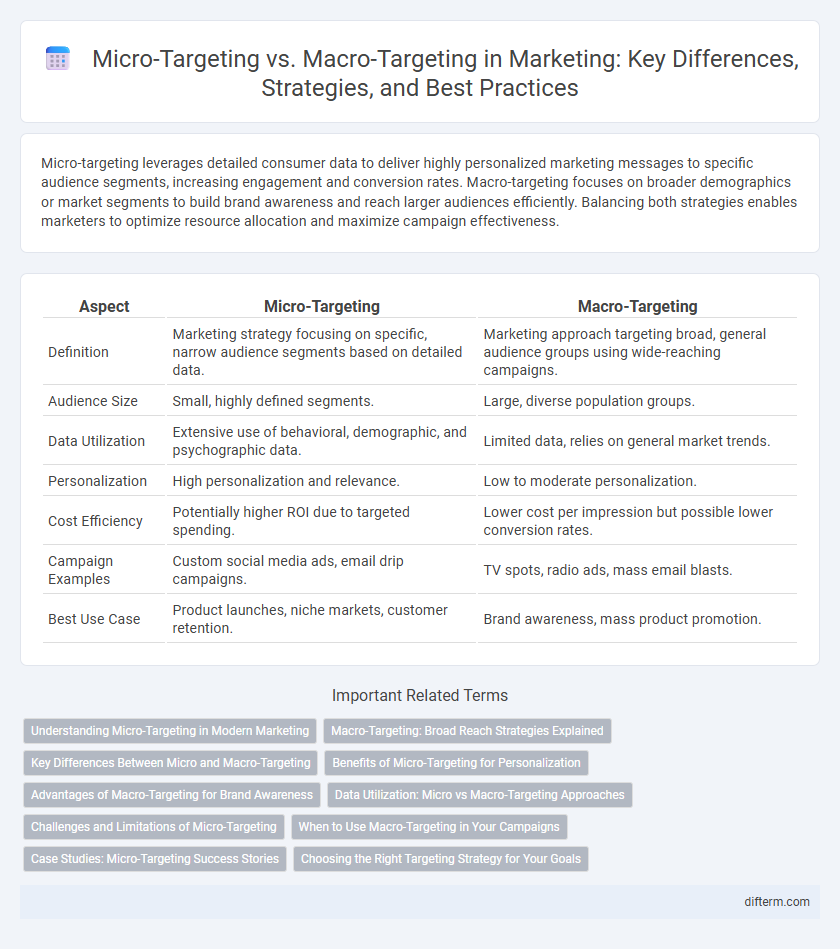Micro-targeting leverages detailed consumer data to deliver highly personalized marketing messages to specific audience segments, increasing engagement and conversion rates. Macro-targeting focuses on broader demographics or market segments to build brand awareness and reach larger audiences efficiently. Balancing both strategies enables marketers to optimize resource allocation and maximize campaign effectiveness.
Table of Comparison
| Aspect | Micro-Targeting | Macro-Targeting |
|---|---|---|
| Definition | Marketing strategy focusing on specific, narrow audience segments based on detailed data. | Marketing approach targeting broad, general audience groups using wide-reaching campaigns. |
| Audience Size | Small, highly defined segments. | Large, diverse population groups. |
| Data Utilization | Extensive use of behavioral, demographic, and psychographic data. | Limited data, relies on general market trends. |
| Personalization | High personalization and relevance. | Low to moderate personalization. |
| Cost Efficiency | Potentially higher ROI due to targeted spending. | Lower cost per impression but possible lower conversion rates. |
| Campaign Examples | Custom social media ads, email drip campaigns. | TV spots, radio ads, mass email blasts. |
| Best Use Case | Product launches, niche markets, customer retention. | Brand awareness, mass product promotion. |
Understanding Micro-Targeting in Modern Marketing
Micro-targeting in modern marketing leverages detailed consumer data and behavioral insights to create highly personalized campaigns aimed at specific segments, enhancing engagement and conversion rates. Advanced analytics and AI enable marketers to identify niche audiences based on demographics, interests, and online activity, ensuring more relevant messaging. This precision in targeting contrasts with macro-targeting's broad approach, driving improved ROI through tailored content and optimized ad spend.
Macro-Targeting: Broad Reach Strategies Explained
Macro-targeting employs broad reach strategies to engage large, diverse audiences by utilizing mass media channels such as television, radio, and major social platforms. This approach maximizes brand visibility and awareness, driving high-volume impressions and fostering general market presence. Businesses leverage data analytics to identify demographic and psychographic trends that inform broad campaign designs targeting wide audience segments.
Key Differences Between Micro and Macro-Targeting
Micro-targeting focuses on highly specific audience segments using detailed demographics, behaviors, and preferences to tailor personalized marketing messages that increase engagement and conversion rates. Macro-targeting targets broader audience groups based on general characteristics such as geographic location, age ranges, or industry sectors to build widespread brand awareness and reach larger market shares. Key differences include granularity of data used, customization level of campaigns, and the primary marketing objectives--precision and relevance for micro-targeting versus scale and visibility for macro-targeting.
Benefits of Micro-Targeting for Personalization
Micro-targeting enables marketers to deliver highly personalized content by analyzing specific audience segments based on detailed demographic, behavioral, and psychographic data. This approach increases engagement rates and conversion by addressing individual preferences and pain points with tailored messaging. Enhanced personalization through micro-targeting cultivates stronger customer loyalty and improves overall campaign ROI.
Advantages of Macro-Targeting for Brand Awareness
Macro-targeting enhances brand awareness by reaching a broader audience across diverse demographics, increasing overall visibility and recognition. It enables marketers to leverage mass media channels such as television, radio, and social media platforms to create widespread brand exposure. This strategic approach supports consistent messaging and reinforces brand identity on a large scale, fostering long-term customer loyalty and trust.
Data Utilization: Micro vs Macro-Targeting Approaches
Micro-targeting leverages granular data such as individual demographics, online behaviors, and purchase history to deliver personalized marketing messages that increase engagement and conversion rates. Macro-targeting relies on broader datasets like regional trends, market segments, and general consumer profiles to shape mass marketing strategies aimed at large audiences with shared characteristics. The effective utilization of data in micro-targeting allows for higher precision and ROI, while macro-targeting emphasizes brand awareness and market penetration across wider groups.
Challenges and Limitations of Micro-Targeting
Micro-targeting faces challenges such as privacy concerns, data accuracy issues, and high costs associated with collecting and analyzing granular consumer data. Limitations include potential audience saturation, reduced campaign scalability, and difficulties in maintaining message consistency across highly segmented groups. These factors can impede the effectiveness and ROI of micro-targeted marketing campaigns compared to broader macro-targeting strategies.
When to Use Macro-Targeting in Your Campaigns
Macro-targeting is ideal for campaigns aiming to build broad brand awareness across large, diverse audiences and establishing a strong market presence. It excels when launching new products or entering new markets where general messaging can attract wide interest and maximize reach. Employ macro-targeting to efficiently allocate budget toward high-volume impressions and drive widespread engagement on mass media platforms.
Case Studies: Micro-Targeting Success Stories
Micro-targeting leverages detailed consumer data and behavioral insights to create personalized marketing campaigns, resulting in highly efficient audience engagement and conversion rates. Companies like Amazon and Netflix harness micro-targeting techniques to deliver tailored recommendations and promotions, significantly boosting customer retention and sales. Case studies reveal that micro-targeted campaigns achieve up to 30% higher ROI compared to broad macro-targeting strategies by focusing on niche audience segments.
Choosing the Right Targeting Strategy for Your Goals
Micro-targeting leverages precise data analytics and customer behavior insights to reach niche segments with personalized messaging, maximizing engagement and conversion rates. Macro-targeting focuses on broad demographic or geographic groups, ideal for brand awareness campaigns aiming for mass market reach and scalability. Selecting the right targeting strategy depends on campaign objectives, budget allocation, and desired customer interaction depth.
Micro-targeting vs macro-targeting Infographic

 difterm.com
difterm.com